Lars Martinson's Blog, page 3
September 26, 2016
“Tonoharu: Part Three” Media Flyer
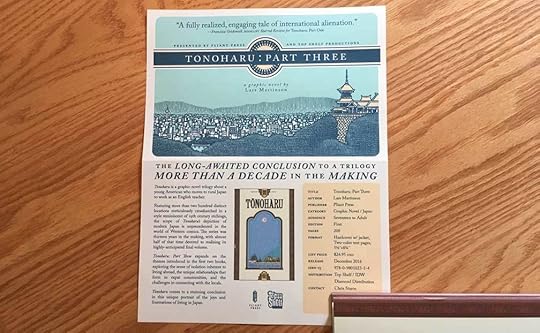
Marketing flyer for Tonoharu: Part Three.
First off, exciting news! The main shipment of Tonoharu: Part Three arrived at the distributor late last week!
Apparently it takes “a few days” for books to be processed and put into the distributor’s computer system. After that happens, they’ll send some copies to me via UPS Ground, which will take another few days.
So when will I have copies available for sale through my website? I don’t know exactly, but I’d imagine I’ll get them sometime next week or the week after…? Not long now, in any event. I’ll keep you posted!
**************************************
With the release just around the corner, I’ve begun preparations for the MASSIVE MARKETING PUSH I intend to give the third and final volume of Tonoharu. A big part of that is sending out review copies to media people. In addition to the book itself, I send out a promotional flyer to try to pique reviewers’ interest.
As I’ve done for past Tonoharu marketing materials, I’ve gone for a classy, “Oscar bait” type design for the flyer.
I was careful to make sure that the design folded neatly in half, with the top half having a strong visual hook and the bottom half having all the important information about the book. This perfectly fits the size of the book: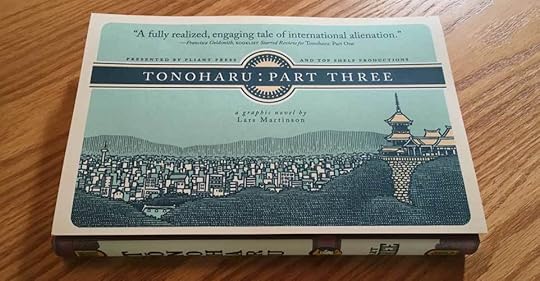
For the actual ad copy, I decided to emphasize Tonoharu’s absurdly long development and ill-advised scope:
**************************************
The LONG-AWAITED CONCLUSION to a Trilogy MORE THAN A DECADE in the MAKING
Tonoharu is a graphic novel trilogy about a young American who moves to rural Japan to work as an English teacher.
Featuring more than two hundred distinct locations meticulously crosshatched in a style reminiscent of 19th century etchings, the scope of Tonoharu’s depiction of modern Japan is unprecedented in the world of Western comics. The series was thirteen years in the making, with almost half of that time devoted to realizing its highly-anticipated final volume.
Tonoharu: Part Three expands on the themes introduced in the first two books, exploring the sense of isolation inherent to living abroad, the unique relationships that form in expat communities, and the challenges in connecting with the locals.
Tonoharu comes to a stunning conclusion in this unique portrait of the joys and frustrations of living in Japan.
**************************************
So there you have it! If you just can’t get enough of my sweet design work, you can click here for a full-sized version of the flyer. (446kb PDF file).
See ya next Monday!
September 19, 2016
“Tonoharu” Media Page
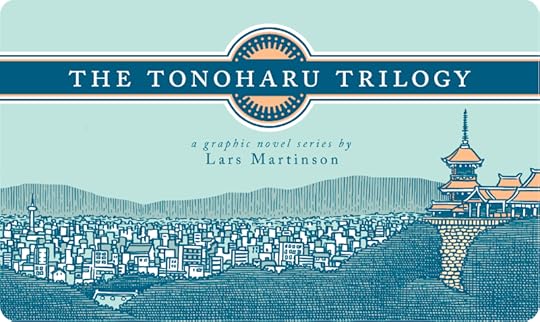 The main shipment of copies of Tonoharu: Part Three is currently in the US, traveling by rail. They should arrive to the distributor this week, and then the distributor will send some of them to me. So I’m hoping to get my hands on them some time late this month or in early October (knock on wood).
The main shipment of copies of Tonoharu: Part Three is currently in the US, traveling by rail. They should arrive to the distributor this week, and then the distributor will send some of them to me. So I’m hoping to get my hands on them some time late this month or in early October (knock on wood).
Once I have a bunch of copies on hand, I hope to start contacting media people in earnest to try to drum up interest. I still haven’t decided what my e-mail “pitch” is going to look like, but I figure it should be short and sweet, and conclude with a web link they can go to in case they want more information. I want that link to be a “one stop shop” for info about Tonoharu, including what it is, links to sample artwork, and stuff like that.
So that’s been my project this week. Here’s the page I’ve cobbled together:
http://larsmartinson.com/tonoharu
The Tonoharu media page is a work in progress, so if you have any comments or criticisms, I’m all ears!
Also! If anyone knows of any websites/blogs/magazines/newspapers/reporters/etc., etc., that they think would be interested in Tonoharu, please let me know! It’d be very useful.
Okay, that’ll be it for this week. See you next Monday!
September 12, 2016
Attention Strangers: Please Give Me Your Money.
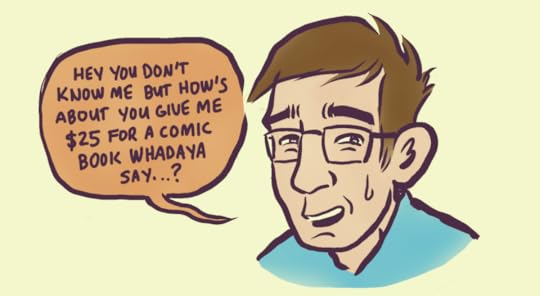 Pictured: a face you can trust
Pictured: a face you can trust
According to this New York Times article, the average American knows 600 people.
Let’s say for the purpose of argument that the New York Times figure is accurate, and that my social network is “average”. Let’s also say that 10% of those 600 people buy my books. (I’m guessing that’s a pretty optimistic estimate if anything, but again, just for the purpose of argument.)
So that’s 60 sales I would make from people that I know personally.
Needless to say, I have to sell a lot more books than that to make publishing them economically viable. That means the majority of my sales need to come from complete and total strangers who have no emotional investment in me or my personal success or failure.
I guess that’s obvious if you think about it, but I find it’s helpful to keep in mind when I’m thinking about the best way to promote my work.
Take these two facts which I might use for promotional purposes:
1) I was covered in the Wall Street Journal.
2) My graphic novel Tonoharu has been translated into French and Spanish.
If I’m talking to my mom, or a friend, or even an acquaintance, those two facts by themselves would probably be of (at least mild) interest.
But if it’s someone that’s never met me, this “news” suddenly becomes a lot less interesting:
1) [A complete stranger] was covered in the Wall Street Journal.
2) [Some book you’ve never heard of] has been translated into French and Spanish.
Like, who cares? Lots of people you don’t know are covered in the WSJ. Lots of books you’ve never heard of are translated into other languages. If you don’t have any connection to me, these facts (by themselves) are unlikely to be of any interest.
If my promotional materials read like a family newsletter detailing my middling achievements, it’s unlikely to interest anyone who doesn’t know me personally. And since my potential audience is mostly comprised of strangers, it’s important to find creative ways to capture their attention. Every promotional effort needs some kind of hook.
Which brings me to the YouTube book trailer I’m working on to coincide with Tonoharu: Part Three’s release this November.
Now, I could title the video Official Book Trailer for Tonoharu: Part Three and show a montage of artwork over a royalty-free soundtrack. That would be a perfectly acceptable route… but also a route that would be unlikely to get many views outside of friends and family.
Because again, if I put myself in the shoes of someone who doesn’t know or care about me or my work, that video may as well be called: Official Book Trailer for [some book you’ve never heard of]. Probably not something they click on (or even see a link for in the first place for that matter).
So instead, I’ve decided to take a completely different approach. So different that it’s not really even a book trailer anymore (at least not in the traditional sense).
The video is centered around why Tonoharu took so absurdly long to complete, and the lessons I learned that I intend to apply to future artistic projects. I’ll probably call it something click-bait-y like:
4 Time Management Tips (from someone who spent 13 years on a graphic novel).
I dunno, maybe it still won’t get many views, but I figure it’s a lot more intriguing than generic book trailer #8736472. It’s been a lot more fun to work on, in any event. Anyway, I’m about 25% done with it, and will link to it once it’s done.
Okay, I’ve been rambling on about marketing for long enough. See you next Monday!
September 5, 2016
“Tonoharu: Part Three” Art Preview Summer 2016
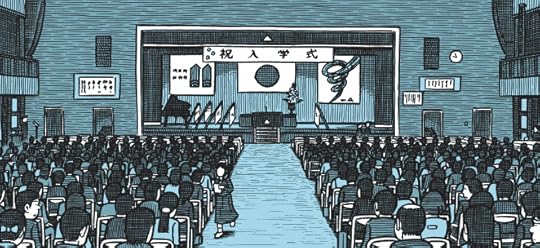
Full-size version of this picture available at the link below!
As promised, this week I wanted to put up something Tonoharu: Part Three related. When I checked back on previous blog entries, I realized that the only art preview I did went up almost two years ago; yeesh! So I figured it was high time to put up another one.
To save my poor old website the bandwidth, I’ll just post the artwork on Facebook:
https://www.facebook.com/media/set/?set=a.10152685207948913.1073741831.594318912&type=1&l=bc22253804
That album also includes the images I put up in 2014, so check that out if you missed it the first time.
I’ll post one more art preview around the time the book is released in November. I saved the best for last, so check back!
Next Monday’s entry will also be Tonoharu related (I think). See you then!
August 29, 2016
My Dream (Day) Job
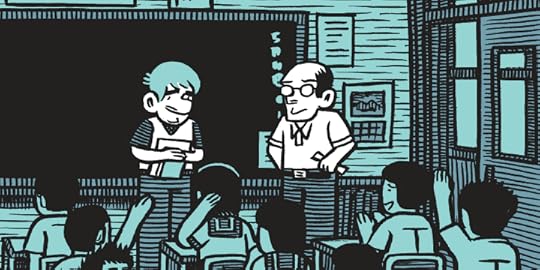
Ten years ago at my grandmother’s 90th birthday party my mom gave a speech. Grandma had been a teacher, so Mom rattled off a list of children and grandchildren that were also educators. I jolted a bit when I heard my own name among them. It actually confused me for a quick second. What’s she talking about? I’m not a teacher, I thought.
But of course I was. I had just wrapped up a three year stint teaching English in Japan. In the decade since, I’ve added another five years to that tally. The eight years I’ve spent teaching eclipses all the other jobs I’ve had by a pretty significant margin, both in terms of time spent and money earned. But in spite of all that, it still feels a little weird to call myself a teacher. I think this has a lot to do with the capacity in which I was employed.
For both of my teaching gigs I worked as an Assistant Language Teacher (or an “ALT”) through “JET” (a work exchange program run by the Japanese government). To become a JET ALT, you just need to be from an English speaking country and have a bachelor’s degree in anything; no prior teaching experience or certification is required. Due to the lack of formal teaching training, JET ALTs are required to teach with a Japanese teacher who they assist (in theory at least). Opportunities for advancement are nil, and you can only do the JET Program for a maximum of five years. It is, by design, not something you can easily parlay into a career.
Ironically, ALTs with a background in education were often the most frustrated with the job. An ALT’s role in the classroom varies greatly, but is often extremely limited. It isn’t at all unusual to be put in charge of a five minute warmup game, maybe spending a few minutes doing a pronunciation exercise, and then spend the rest of the class standing awkwardly off to the side while the “real” teacher explained grammar points in Japanese. Outside of class, there was often even less to do, especially during summer vacation or midterms.
So I can understand why the job would leave people dissatisfied. But personally, while teaching isn’t my calling, I begrudgingly enjoy it in spite of myself. I never really looked forward to going to Monday morning, but I didn’t dread it either. Once I got to work, the day usually flew by. And the thing that drove a lot of ALTs crazy, all the free time, was fine with me. After I finished lesson plans, I’d just study Japanese or work on comic scripts or something.
So I can’t say working as an ALT is my dream job. But it just might be my dream day job. I took it seriously for what it was, taught whatever classes I had that day, and then went home and forgot about it. The steady paycheck, low stress, and lack of overtime let me devote my evenings and weekends to my true passion, comics. I could see myself being content working as an ALT indefinitely (which I’m sure would shock the me of ten years ago).
My tenure as a JET ALT is over and I’m back in the States for now, but within the next year or two, I hope to make it back to Japan to work as an ALT again. I don’t know how viable this is, but I’d really love to find a decent part-time ALT position. I think that would be the perfect balance between steady income and having enough time to devote to my art.
As I understand it, landing a decent ALT position outside of the JET Program is no easy task. Even with my eight years of experience I don’t think I’d necessarily be a shoo-in. So I hope to get some teaching certification and look for other ways to help improve my employability in the coming months.
Which brings me to my ulterior motive for writing this blog entry. If anyone out there has any insight about landing a decent ALT job outside of the JET Program, I’d be all ears! I’m particularly interested in in what kind of teaching certification/program I should look into, as that’s the next step for me in the short term. This blog has been inactive for so long maybe there’s not anyone reading with experience in this area, but I figured it wouldn’t hurt to ask. Thanks!
Next Monday’s blog entry will be about Tonoharu: Part Three. Stay tuned!
August 22, 2016
Update: “Tonoharu: Part Three” still coming out this year, I’m still alive
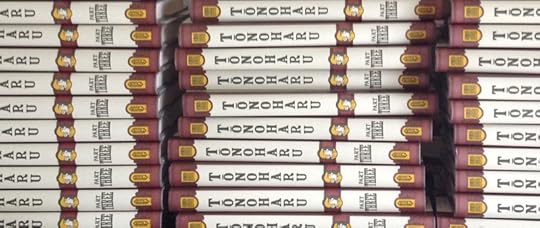 Pictured: Advance copies of Tonoharu: Part Three
Pictured: Advance copies of Tonoharu: Part Three
The last blog entry I wrote prior to this one concluded with me writing “expect more frequent blog updates in the future”.
That entry was written almost nine months ago.
So yeah, it’d be an understatement to say that I’ve been truly awful at updating this blog. This is particularly bad considering the third and final book of Tonoharu is releasing in just a few short weeks. But oh well. Only thing to do now is try to be better about it from here on out.
So rather than vaguely promise “more frequent” blog entries, lemme be a bit more concrete. I’m going to post a new blog entry every Monday morning until at least the end of the year, and hopefully beyond that. Some of these entries will be substantial, others might just be a link to a YouTube video or something. But there will, in the very least, be something.
I’ll save details for future entries, but to just briefly recap on what’s happened in the past nine months:
Tonoharu: Part Three will be released in November of this year.
The books have already been printed and bound, and at the time of this writing are on the boat over from South Korea. I might have copies available for sale through my website as early as October. Will update on the blog when I know more. (Really!)
I’ve moved back to the United States as of a couple weeks ago.
People who read the blog back when I actually updated it may recall I was living in Kyoto last time I wrote. My work contract has concluded, and so I’m back in the States (for now). I’ll write more about my feelings about this and what I plan to do from here on out in future blog entries. (I swear!)
I’ve started post-Tonoharu artistic work, and have 95% completed a short test project.
Having worked on the same series for so dang long, I was anxious to try something completely different. So different in fact that I felt like it was a good idea to try out a short test project or two before I tackle anything significant. I’ve already almost finished one of these test projects, and hope to release it by the end of the year. Again, future blog updates will cover this in complete detail. (No kidding!)
My apologies to anyone who came to this blog over the past few months looking for new entries; I’m sure the vast majority of people gave up long ago, but like I say, there will be frequent updates for the next few months or so.
Anyway, see you back next Monday!
November 27, 2015
“Tonoharu: Part Three” FINAL Progress Report
As the “99%” on the progress bar above indicates, there is still a tiny teeny bit of work left before I can call Tonoharu: Part Three unequivocally, 100% complete. I should be able to complete what remains over the course of an afternoon. The only reason I haven’t done so already is because it involves details I need from my book printer, and I won’t have that information until right before I go to press.
But basically, Tonoharu: Part Three (and by extension, the entire Tonoharu story) is now DONE.
As you might imagine, reaching this milestone has put me in a contemplative mood.
I can’t remember exactly when I started Tonoharu (which is telling in and of itself), but I believe it was late 2003. This means I’ve been working on it for like TWELVE YEARS. I took breaks here and there due to illness, injury, and burnout, but those breaks were few and far between. Even accounting for those hiatuses, I think it’d be conservative to estimate that I put a good decade of almost daily work into Tonoharu.
So after all that, how does it feel to be done with it? In a word, weird.
It’d be like if someone came up to you and said, “Okay, you’ve been brushing your teeth for years and years now… congratulations! You have now completed the task of toothbrushing. You don’t have to do it anymore.”
Brushing your teeth is just something you do everyday, forever. It’s not a task that you complete. I’ve been working on Tonoharu for so long, it’s started to feel like that. A part of the daily routine. To think that I’ve completed this thing that I’ve devoted more than half of my adult life to is hard to wrap my brain around.
As such, I’ll leave it at that for now. I’ll write a more detailed postmortem about Tonoharu in a few months, after I have a bit more perspective.
But for now, I’ll reaffirm that we’re still totally on track to meet the previously announced October 2016 release date for Tonoharu: Part Three. (I wrote about why I set the release date so far out in this blog entry, if you’re curious.)
With the release of the book now less than a year away, I’m hoping to start ramping up my marketing efforts again. So expect more frequent* blog updates in the future as well.
*(Admittedly, it’d be hard to update less frequently, but…)
May 29, 2015
“Tonoharu: Part Three” Progress Report (Spring 2015)
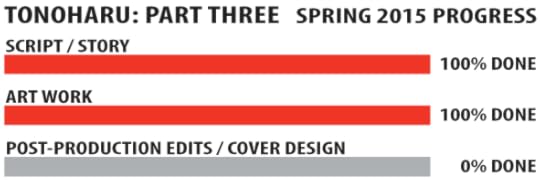
Just today I passed a significant milestone: I finished the artwork for the last page of Tonoharu: Part Three! The whole book (and by extension, the whole series) now exists in a complete, readable state. Hurray!
Only two main things remain before the book is 100%, unequivocally done:
1) The Dust Jacket
This includes the front and back cover, the spine, and the inside front and back flaps. It will follow the same basic template as the first two Tonoharu hardcovers, so there won’t be much design work to worry about, but the front cover artwork will be as intricate as ever, so I expect will take a few weeks (a couple months?) to finish.
2) Post-Production Work
2a) Housingkeeping
At the bare minimum, I need to go through all the panels and fix any spelling mistakes, tweak the text layout and word balloons, and confirm that all the files are set up correctly to go to press. Completing these minimal edits shouldn’t take too long on a per-panel basis: I’d estimate less than two minutes per panel. But since the book contains over 700 panels, (and since I can only work on it on evenings and weekends since I have a day job) it’ll probably take a few weeks to finish.
2b) Artwork Edits
What’s more of a wild card is the artwork edits. The entire book now exists in an acceptable state, but I’d still like to go back and fix some of the artwork that I’m not happy with. Most of these edits should be minor, like redrawing a character’s face and using Photoshop to Frankenstein it into the preexisting art. In rare cases, I might redraw panels from scratch, or add a couple of pages here or there to help with the flow of the story.
For Tonoharu: Part One, I did artwork edits to pretty much 100% of the panels (in some cases, even editing them two or three times). For Tonoharu: Part Two, I only did it for about half of the panels. I’d like to continue the downward trend with the third book, and only do art edits to 25% of the book (or less; we’ll see how much I can keep my perfectionism in check).
Between the housekeeping stuff and the artwork edits, I expect the post-production work to take a few months to complete.
So to sum up: I estimate the remaining work on Tonoharu: Part Three should take about half a year to complete. This means I should be totally done with it right around the end of the year.
This still puts me on track for my planned October 2016 release. (For details as to why I plan to release it ten months after my anticipated completion date, see this entry.)
I’ll probably also unveil the cover for Tonoharu: Part Three sometime this summer, and then will put up the final Tonoharu: Part Three progress report a few months after that. So stay tuned!
January 7, 2015
Temping Fate: My Prediction for Tonoharu: Part Three’s Release Date
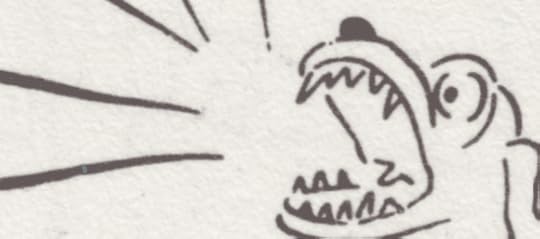
I’m too lazy to create a header image for this blog entry so here’s a barking dog from Sazae-san
Just this week, I finished the last page of the appendices for Tonoharu: Part Three, leaving only the epilogue left to draw. Needless to say, I’m excited to pass this milestone. As I do whenever I finish a page, I tweeted about it. The standard format for these update tweets looks like this:
Tonoharu Part 3, page 159 is done!
Approx. 22 pages left to go!
I always feel a little sheepish tweeting these countdown micro-updates, because I’m afraid they’re a bit misleading. At the rate I’m going, all of the pages should be “done” by this summer. One could (reasonably) assume that the book would come out soon after that. But unfortunately, that’s not going to be the case.
So when do I expect the book to come out? We’ll see if my hubris bites me in the ass, but I feel confident projecting that Tonoharu: Part Three will be released in October…2016.
So why, if I expect to be “done” with all the pages by Summer 2015, do I project a release more than a year after that?
There are a couple of reasons.
First off, my micro-update tweets aren’t entirely accurate. Twitter’s 140 character limit doesn’t allow for disclaimers, but if it did, I might note that I’m defining a page as being “done” when it exists in an acceptable, readable state. The text and artwork are in place, and nothing strictly essential is missing.
What I’m not including when I call a page “done” are the inevitable post-production edits. Most of these edits will be small, like fixing spelling mistakes and tweaking dialogue. Less often I’ll edit the actual artwork, or maybe even redraw entire panels. But even though most of these edits will be small, I’ll have more 700 panels to go through, and that will take time. I expect this stage to take a few months to complete.
In addition to that, I have the front and back covers left to draw. That probably seems like a weird thing to single out as a time sink, but as with previous installments, the cover will be extremely intricate, so I expect that to take a few weeks to complete.
Taking all that into consideration, I expect to be completely, unequivocally done with Tonoharu: Part Three by late 2015 / early 2016.
In spite of that, I’m still planning for a late 2016 release. The main reason for this is strategic.
I’m currently working a full-time day job. My contract will wrap up late-July 2016. After that, I intend to live off my savings and devote myself to comics exclusively for at least a year.
By delaying Tonoharu: Part Three’s release a few months, I’ll push its release into this “no day job” period. This will allow me to devote much more time to marketing it during the critical release period.
I’m invested in the success of every book I put out of course, but it seems especially important at this stage in my artistic career. I don’t want to be melodramatic here, but I’d say there’s at least a fair chance that Tonoharu: Part Three could be the last book I ever put out if things go particularly poorly.
In any event, the more money Tonoharu brings in, the better position I’ll be in for future artistic projects.
I could write more, but this entry is already pretty long so I think I’ll save further ramblings for another time. But for now, I’ll say it again, with an uncharacteristic lack of equivocation: Tonoharu: Part Three will come out in October 2016. Get hyped!
November 30, 2014
My Experience at the Kaigai Manga Festival
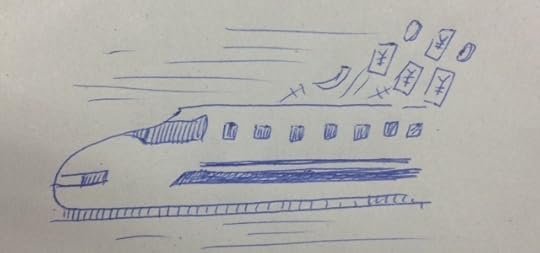
Pictured: The Fast Track to Bankruptcy
On November 23rd, I had a table at the Kaigai Manga Festival in Tokyo. How it went depends on how you look at it. On one hand, I had the best sales I’ve ever had. On the other hand, it was my least profitable show ever.
To understand why, I should explain how comic book conventions have gone for me historically. Over time, there’s been a trend towards higher sales. I attribute this to better table presentation and sales technique, and to being more selective about which shows I go to.
That said, it’s important to put this “upward trend” into perspective. My work hardly has universal appeal, I only have three different things to sell, and I haven’t put out anything new since 2008. For even my best show, I’ve never made more than a few hundred dollars in sales.
That’s fine, but only if expenses are low as well. Up until now, I’ve only done shows in Minnesota, my home state. With no plane tickets or hotels to pay for, my expenses have just been for the table rental itself, which is negligible in the scheme of things.
Which leads me back to the Kaigai Manga Festival, the first show I’ve ever actually had expenses for.
I currently live in Kyoto, so I didn’t have international plane tickets to pay for or anything. But getting from Kyoto to Tokyo and back is actually pretty expensive, especially if you’re unwilling to take an excruciating, eight hour night bus. In order to get there and back comfortably in a single day, I had to buy two full price Shinkansen tickets. (You can get discounted Shinkansen tickets, but not for early in the morning or late at night, which is what I needed.) These travel expenses ate into my record sales to the extent that financially, the show was basically a wash.
But before you think I’m down on the experience or regret doing it, I’d like to briefly talk about what was, previously, my least profitable show ever. That being the first show I ever did, SpringCon, back in 2010.
The show is very super hero-centric, so not exactly my crowd. I only had two things to sell. My table looked awful. My “sales technique” amounted to sitting hunched over my drawing pad, ignoring anyone who walked by unless they addressed me first. I honestly can’t remember how many books I sold, but I do remember figuring out I couldn’t even pay myself minimum wage for the time I spent there. At the time, I was disheartened.
But as I eventually discovered, same day book sales aren’t the only reason to do conventions. The show allowed me to reconnect with members of the Minnesota cartooning scene after a long absence. These connections were gratifying in there own right, and also eventually landed me a few paying gigs.
At the Kaigai Manga Festival, I met a representative for a major Japanese book store chain who felt my work might be a good fit for their English book section. Time will tell if that pans out, but if it does, that could result in sales over the next few years that wouldn’t have occurred if I hadn’t been at the show.
I also met a lot of great members of the cartooning community, like Victor Edison and Deb Aoki among others. For someone who has devoted their life to comics, I’m embarrassingly out of touch with the current comics scene, so it’s good to get a chance to reconnect with it a little bit.
If the travel expenses weren’t an issue, I’d definitely go to Kaigai Manga Festival next year. It’s well run and as I said, resulted in my best sales ever. If you’re a cartoonist who lives in the Tokyo area, I’d recommend it.
As it stands, with the travel expenses being what they are, I’m still deciding if I’m going to participate next year. It might be worth doing if I combined it with a mini-vacation to Tokyo or something. We’ll see.
That said, sales were encouraging enough that I’ve decided to try a similar show in Osaka next May. I can get to Osaka for one-tenth the cost of getting to Tokyo, so if I manage to pull off similar sales, it’d be well worth it. More details on that in the months to come!
Lars Martinson's Blog
- Lars Martinson's profile
- 24 followers




